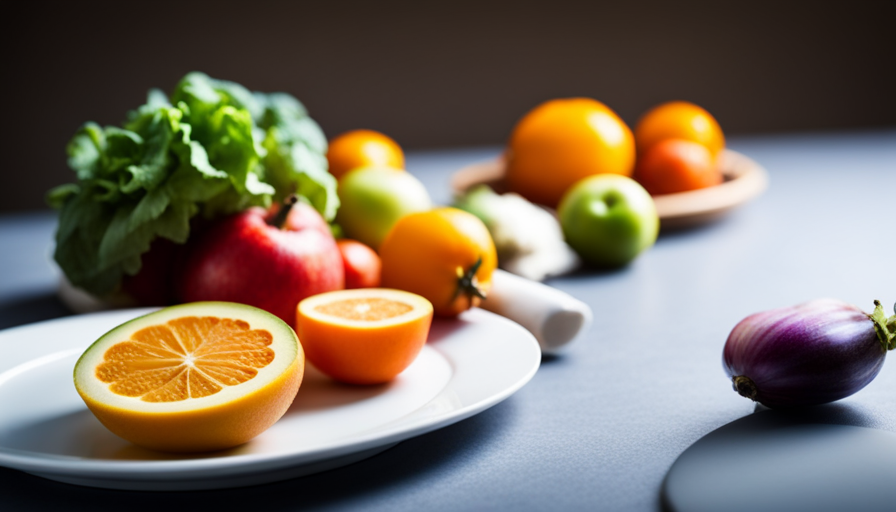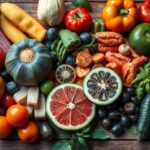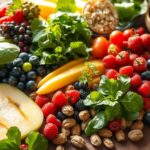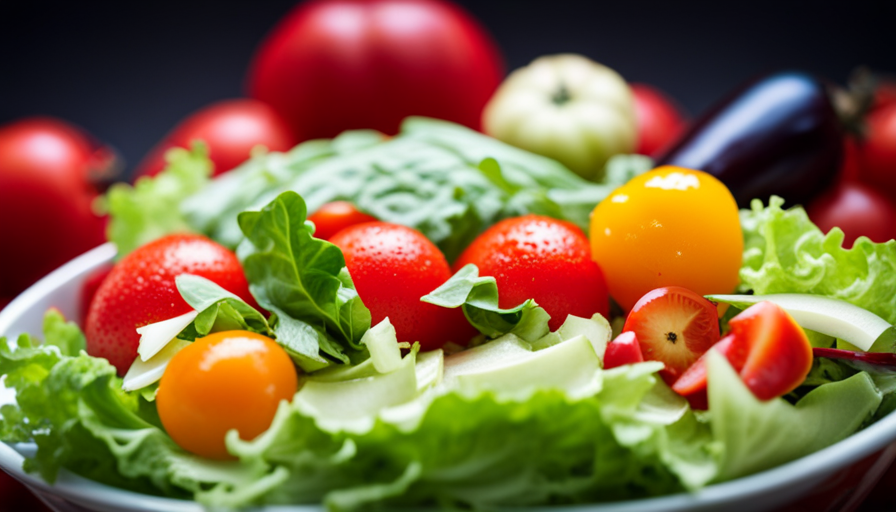Ah, the appeal of the raw food diet, where everything is fresh, colorful, and packed with nutrients. It’s like entering a garden of wellness, isn’t it? However, before jumping in headfirst, it’s important to consider the downsides that often get overlooked. As someone who has explored the realm of raw food, I can attest that it’s not always smooth sailing.
From nutritional deficiencies to digestive issues, limited food options to time-consuming meal preparation, this diet has its fair share of drawbacks. And let’s not forget the potential weight gain and nutrient loss that can occur. Plus, sustaining this diet long-term can be quite the challenge. Add in the social implications and the lack of scientific evidence, and you’ve got yourself a recipe for disappointment.
So, before you take a bite of that raw carrot, let’s dive into the cons of the raw food diet and see if it’s really worth it.
Key Takeaways
- Raw food diet can lead to nutritional deficiencies due to lack of cooked foods that enhance nutrient absorption.
- Raw foods can carry harmful bacteria like Salmonella and E. coli, increasing the risk of foodborne illnesses.
- Limited raw food options can make it challenging to meet nutritional needs and enjoy a variety of meals.
- Raw food diet may not provide enough essential nutrients like protein, iron, and vitamin B12 without supplementation.
Nutritional Deficiencies
You may experience nutritional deficiencies on a raw food diet due to the lack of certain cooked foods that provide essential vitamins and minerals. While raw fruits, vegetables, nuts, and seeds are rich in many nutrients, the cooking process can actually enhance the bioavailability of certain nutrients, making them easier for our bodies to absorb.
For example, cooking tomatoes increases the absorption of lycopene, a powerful antioxidant that may help reduce the risk of certain cancers. Additionally, cooking can break down the cell walls of plants, making it easier for our bodies to access the nutrients inside.
Another concern with the raw food diet is its long-term sustainability. It can be challenging to meet all of our nutritional needs solely through raw food, as certain nutrients may be lacking or less bioavailable. For instance, plant-based iron sources like spinach and lentils are more easily absorbed when cooked. Similarly, cooked legumes offer a complete source of protein, while raw legumes may be more difficult to digest and utilize.
Transitioning into the subsequent section about digestive issues, it’s important to note that the raw food diet can also lead to various digestive issues due to its high fiber content.
Digestive Issues
When it comes to the raw food diet, there are a couple of key points to consider in terms of digestive issues. Firstly, some individuals may find it difficult to digest raw foods due to their higher fiber content and lower enzyme activity. This can lead to bloating, gas, and discomfort.
Secondly, there’s an increased risk of foodborne illnesses when consuming raw foods, as they aren’t cooked at temperatures that kill harmful bacteria and parasites. These risks can be mitigated by thoroughly washing and preparing raw foods, but it’s still something to be aware of when following a raw food diet.
Difficulty digesting raw foods
Imagine trying to digest raw foods—it’s like asking a toddler to break open a coconut with their bare hands. It’s just too much to handle. While the raw food diet has its benefits, such as increased nutrient intake and preservation of enzymes, it also presents challenges when it comes to digestion. Here are some cons of difficulty digesting raw foods:
-
Raw foods are harder to break down. The body has to work harder to extract nutrients from raw foods, which can lead to digestive discomfort and bloating.
-
Reduced bioavailability of nutrients. Cooking food increases the bioavailability of certain nutrients, making them easier for the body to absorb.
-
Limited food options. The raw food diet eliminates many cooked foods, which can lead to a limited variety of options and potential nutrient deficiencies.
-
Risk of bacterial contamination. Raw foods can be more susceptible to bacterial contamination, increasing the risk of foodborne illnesses.
Considering these challenges, it’s important to weigh the pros and cons before adopting a raw food diet. Transitioning to the next section, let’s explore the increased risk of foodborne illnesses.
Increased risk of foodborne illnesses
Now, let’s delve into how you can be more susceptible to foodborne illnesses when increasing your intake of uncooked foods.
The raw food diet has gained popularity for its health benefits, but it also presents some risks. Raw foods, especially fruits and vegetables, can carry harmful bacteria like Salmonella, E. coli, and Listeria. These pathogens can cause food poisoning and lead to symptoms such as nausea, vomiting, diarrhea, and in severe cases, even hospitalization.
Additionally, raw foods have a higher potential for nutrient loss compared to cooked foods. Certain nutrients, like vitamins A, D, E, and K, are better absorbed when cooked. Transitioning to a raw food diet means relying on uncooked foods, which limits the available options for meals and can pose a challenge for maintaining a balanced diet.
Limited Food Options
One drawback of the raw food diet is that it restricts your food options, making it difficult to enjoy a variety of cooked meals. This can be especially challenging for individuals who have specific dietary preferences or restrictions.
Here are some reasons why limited food options may be a concern on the raw food diet:
-
Nutrient deficiencies: The raw food diet eliminates many cooked foods, such as grains, legumes, and animal products, which are important sources of essential nutrients like protein, iron, and vitamin B12. Without careful planning and supplementation, individuals on the raw food diet may be at risk of nutrient deficiencies.
-
Potential weight gain: While the raw food diet is often associated with weight loss, it can actually lead to weight gain in some individuals. This is because raw foods tend to be less calorie-dense than cooked foods, which means you would need to consume larger quantities of raw food to meet your energy needs. This can result in an excessive calorie intake and potential weight gain.
-
Social limitations: Following a raw food diet can be challenging when dining out or attending social events. Many restaurants and social gatherings may not offer a wide variety of raw food options, making it difficult to stick to your diet and enjoy meals with others.
-
Psychological impact: Restricting your food options to only raw foods can be mentally taxing and may lead to feelings of deprivation or frustration, especially if you have a strong attachment to cooked foods.
Transitioning into the subsequent section about time-consuming meal preparation, it is important to note that the limited food options of the raw food diet often require extensive time and effort for meal preparation.
Time-consuming Meal Preparation
Transitioning into the subsequent section, it’s important to note that meal preparation on the raw food diet can be time-consuming. While this diet promotes the consumption of uncooked and unprocessed foods, it requires careful meal planning and time management.
Unlike traditional diets, where meals can be prepared in a short amount of time, the raw food diet often involves soaking, sprouting, and dehydrating ingredients. For example, preparing a simple raw food meal like a salad can involve soaking nuts or seeds, chopping vegetables, and making a homemade dressing from scratch. These additional steps can add significant time to the meal preparation process.
Moreover, the raw food diet often requires a greater amount of food preparation than other diets. Since the diet emphasizes fresh fruits, vegetables, nuts, and seeds, individuals following this diet may find themselves spending more time in the kitchen washing, chopping, and blending ingredients. This can be particularly challenging for individuals with busy schedules or limited time for meal preparation.
While the raw food diet offers many potential health benefits, it’s important to consider the time-consuming nature of meal preparation. This diet requires careful meal planning and time management to ensure a variety of nutrient-dense meals.
Transitioning into the subsequent section, it’s crucial to explore the potential weight gain that can occur on the raw food diet.
Potential Weight Gain
When it comes to the raw food diet, one potential drawback is the high calorie intake from certain raw foods. While fruits and vegetables are generally low in calories, some raw foods like nuts and avocados are high in calories and can contribute to weight gain if consumed in large quantities.
Additionally, portion control can be challenging on a raw food diet since many raw foods are nutrient-dense and can be consumed in larger quantities compared to their cooked counterparts. Therefore, it’s important to be mindful of calorie-dense raw foods and practice portion control to avoid potential weight gain.
High calorie intake from certain raw foods
Be cautious about the high calorie intake you may unknowingly consume from certain raw foods, as it could lead to weight gain and hinder your progress towards achieving your health goals.
While the raw food diet promotes the consumption of fresh fruits and vegetables, some of these foods can be surprisingly high in calories. For example, dried fruits like dates and raisins have a concentrated sugar content, which can contribute to weight gain if consumed in excess. Additionally, nuts and seeds, while nutritious, are also calorie-dense and can easily add up if overeaten.
Furthermore, relying solely on raw foods may increase the risk of nutrient deficiencies, as some essential nutrients are better absorbed when cooked. It’s important to be mindful of portion sizes and balance your raw food intake with other nutrient-rich foods to avoid excessive calorie consumption.
Transitioning into the next section, the raw food diet can also pose challenges in terms of portion control.
Difficulty in portion control
Moving on from the high calorie intake concern, another challenge of the raw food diet is the difficulty in portion control. Since raw foods are often less dense in calories, it can be tempting to consume larger quantities to feel satisfied. This can lead to overeating and an excessive intake of nutrients, such as vitamins and minerals, which may have adverse effects on the body. Moreover, meal planning becomes more complex as it requires careful consideration of nutrient balance and variety. To illustrate this, consider the following table:
| Portion Control Challenges | Meal Planning Difficulties |
|---|---|
| Overeating due to low caloric density | Ensuring nutrient balance |
| Difficulty in estimating portions | Limited food choices |
These challenges can make it harder to maintain a well-rounded and balanced diet. With portion control and meal planning difficulties in mind, it is important to address the increased risk of bacterial contamination that comes with consuming raw foods.
Increased Risk of Bacterial Contamination
One potential downside to the raw food diet is that it can increase the risk of bacterial contamination, posing a potential health hazard. When consuming raw foods, there’s a higher risk of cross-contamination compared to cooked foods.
Raw animal products, such as eggs, meat, and seafood, are known to carry harmful bacteria like Salmonella, E. coli, and Listeria. These bacteria can cause foodborne illnesses, leading to symptoms like diarrhea, vomiting, and fever.
Proper food handling is crucial to reduce the risk of bacterial contamination. It’s important to wash fruits and vegetables thoroughly before consuming them raw. Cross-contamination can occur when raw and cooked foods come into contact with each other or when utensils and cutting boards used for raw foods aren’t properly sanitized. Avoiding these practices can help minimize the risk of bacterial contamination.
In addition, certain individuals, such as pregnant women, young children, the elderly, and those with weakened immune systems, are more susceptible to foodborne illnesses. So, it’s essential for them to be cautious when following a raw food diet.
Transitioning to the subsequent section about potential nutrient loss, it’s important to consider that while the raw food diet has its benefits, there are also potential drawbacks to be aware of.
Potential Nutrient Loss
Immerse yourself in the world of nutrients as you explore the potential loss of essential vitamins and minerals when embracing a diet of uncooked, natural fare. Advocates of the raw food diet argue that consuming raw foods preserves the nutrients that cooking can destroy. However, there is a lack of scientific evidence to support this claim.
While it’s true that some nutrients are more heat-sensitive and can be lost during cooking, the potential nutrient loss in a raw food diet is a concern. Certain vitamins, such as vitamin C and B vitamins, are particularly vulnerable to degradation when exposed to heat. However, this doesn’t mean that cooking automatically leads to nutrient loss across all foods. In fact, cooking can enhance the bioavailability of certain nutrients and make them easier for our bodies to absorb.
Additionally, the raw food diet often restricts food groups, such as grains and legumes, which are important sources of nutrients like iron, calcium, and zinc. Without proper planning and variety, individuals following a raw food diet may be at risk of nutrient deficiencies. It’s important to ensure adequate intake of essential nutrients through careful food choices and possibly supplementation.
Transitioning to the subsequent section about the difficulty in sustaining the diet long-term, it’s crucial to consider the potential nutrient loss and the challenges it may pose for individuals following a raw food diet.
Difficulty in Sustaining the Diet Long-term
It can be quite challenging to stick with this way of eating for an extended period of time. While the raw food diet may offer numerous health benefits, there are sustainability challenges that make it difficult to maintain in the long term.
One of the main obstacles to sustaining the raw food diet is the limited food options available. Many staple foods such as grains, legumes, and animal products are typically consumed in their raw form. This can lead to a monotonous and restrictive diet, making it hard to maintain interest and satisfaction over time. Additionally, sourcing high-quality, fresh, and organic produce can be expensive and time-consuming, making it less accessible for some individuals.
Another challenge is the social implications of following a raw food diet. Eating raw food can be seen as unconventional and may lead to social isolation or difficulties when dining out with friends and family. It can be challenging to find suitable options in restaurants or social gatherings, making it harder to sustain the diet in a social context.
Although the raw food diet may have its benefits, the sustainability challenges and long-term viability of following this way of eating should be taken into consideration. It’s important to weigh the potential health benefits against the challenges and make an informed decision about whether this diet is suitable for one’s lifestyle and personal preferences.
Moving on to the next section, let’s explore the social implications of the raw food diet.
Social Implications
Navigating social situations can pose challenges for those following a raw food lifestyle, including feeling like a fish out of water when dining out or attending social gatherings. Here are three social challenges and the emotional impact they can have:
-
Limited food options: When dining out, raw foodists often struggle to find suitable options on the menu. This can lead to feelings of frustration and isolation, as they may have to settle for a plain salad while others enjoy a wide variety of cooked dishes.
-
Peer pressure and judgment: Following a raw food diet can draw attention from others who may not understand or support this lifestyle choice. Friends and family members may question the nutritional adequacy of the diet or make snide remarks, causing emotional distress and a sense of alienation.
-
Difficulty in socializing: Food is often a central part of social gatherings, and raw foodists may find it challenging to participate fully in these events. They may have to bring their own food or politely decline certain dishes, which can lead to feelings of self-consciousness and a sense of missing out on shared experiences.
These social challenges can have a significant emotional impact on those following a raw food lifestyle. However, it’s important to note that the lack of scientific evidence supporting the diet’s long-term health benefits is another aspect that should be considered.
Lack of Scientific Evidence
Explore the uncertainty surrounding the long-term health benefits of following a raw food lifestyle, leaving you questioning the validity of claims made about the diet. There is a lack of scientific consensus regarding the raw food diet, with limited research conducted on its long-term effects. This lack of evidence makes it difficult to draw definitive conclusions about the potential health risks associated with this diet.
One of the main concerns with the raw food diet is the potential for nutrient deficiencies. Cooking certain foods can enhance the bioavailability of nutrients, such as iron and lycopene, making them easier for the body to absorb. By consuming only raw foods, individuals may not be obtaining an adequate amount of these essential nutrients. Additionally, some studies have suggested that a raw food diet may lead to a higher risk of nutrient deficiencies, specifically regarding vitamin B12, calcium, and omega-3 fatty acids.
Another concern is the potential for foodborne illnesses. Raw foods, particularly animal products, can be a breeding ground for harmful bacteria, such as Salmonella and E. coli. While proper food handling and preparation techniques can help mitigate this risk, there is still a higher likelihood of contamination when consuming raw foods.
The lack of scientific evidence and consensus surrounding the raw food diet raises concerns about its long-term health benefits and potential risks. Further research is needed to fully understand the implications of this dietary approach.
Frequently Asked Questions
How can I ensure that I am getting all the necessary nutrients while following a raw food diet?
To ensure I’m getting all the necessary nutrients while following a raw food diet, I focus on maintaining a balanced diet. I incorporate a variety of fruits, vegetables, nuts, and seeds to ensure I get a wide range of nutrients.
I also pay attention to food combinations to optimize nutrient absorption. Additionally, I include sources of plant-based protein, healthy fats, and essential vitamins and minerals to meet my nutritional needs.
Regular monitoring of my nutrient levels and consulting with a healthcare professional can also help ensure adequate nutrient intake.
Are there any potential digestive issues that I should be aware of when adopting a raw food diet?
Digestive issues can be a potential concern when adopting a raw food diet. While this diet is rich in fiber, which can aid digestion, it may also lead to bloating, gas, and diarrhea in some individuals.
Additionally, raw foods can be harder to digest, requiring more energy from the body. It’s important to ensure proper food preparation, such as soaking or sprouting, to enhance digestibility.
Nutrient deficiencies can also occur if not carefully planned, so it’s crucial to seek guidance from a registered dietitian.
What are the limitations in terms of food options when following a raw food diet?
When following a raw food diet, there are certain food restrictions that need to be considered. Since the diet primarily consists of uncooked and unprocessed foods, options like cooked grains, legumes, and dairy products are eliminated. This can limit the variety of foods available and make it challenging to meet certain nutritional needs.
Additionally, the raw food diet may lead to potential nutritional deficiencies, particularly in essential nutrients like iron, calcium, and vitamin B12, which are more abundant in cooked foods.
How much time on average does it take to prepare meals on a raw food diet?
Meal prep on a raw food diet can be as time-consuming as building a sandcastle. On average, it takes about 30 minutes to prepare a meal, since most dishes involve simple chopping, blending, or soaking.
To make the process more efficient, I suggest prepping ingredients in bulk, using kitchen gadgets like a food processor, and planning meals in advance. These tips can save precious time and ensure a smooth sailing experience in the realm of raw food meal prep.
Is it possible to experience weight gain on a raw food diet?
Yes, it’s possible to experience weight gain on a raw food diet. The diet promotes weight loss benefits due to its high fiber and nutrient content. However, it’s important to consider portion sizes and overall caloric intake. Consuming excessive amounts of high-calorie raw foods like nuts, seeds, and avocados can lead to weight gain. The long-term effects of a raw food diet on weight management are still not well understood and may vary among individuals.
What are the potential drawbacks of including raw chicken in a raw food diet?
Including raw chicken in a raw food diet can pose significant risks due to the potential for foodborne illness. The “cooked vs raw chicken benefits” show that cooking chicken thoroughly helps to kill harmful bacteria like salmonella and campylobacter, minimizing the risk of infection and ensuring food safety.
Conclusion
In conclusion, the raw food diet may seem appealing with its promise of health benefits and natural goodness. However, it is important to consider the potential drawbacks.
Nutritional deficiencies, digestive issues, limited food options, and time-consuming meal preparation can make it challenging to sustain this diet long-term. Furthermore, there’s a lack of scientific evidence to support its effectiveness.
It’s essential to make informed decisions about our dietary choices based on reliable evidence rather than being swayed by emotional appeals.

















